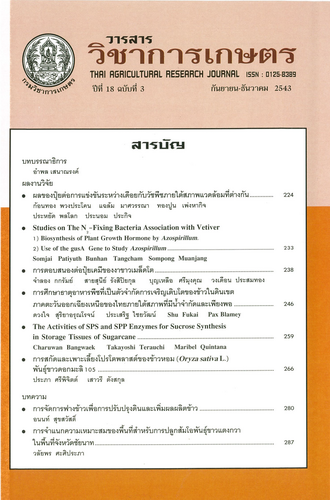การตอบสนองต่อปุ๋ยเคมีของงาขาวเมล็ดโต
DOI:
https://doi.org/10.14456/thaidoa-agres.2000.18คำสำคัญ:
งา, ปุ๋ยเคมีบทคัดย่อ
การศึกษาการตอบสนองต่อปุ๋ยเคมีของงาขาวเมล็ดโต เพื่อหาอัตราปุ๋ยเคมีที่ให้ผลผลิตและผลตอบแทนสูงสุด ดำเนินการในปี 2541-2542 ในไร่เกษตรกรจังหวัดอุบลราชธานี (ดินทรายร่วน) และจังหวัดศรีสะเกษ (ดินเหนียว) วางแผนการทดลองแบบ split plot design 3 ซ้ำ มีงาขาว 3 พันธุ์เป็น main plot คือพันธุ์มหาสารคาม 60 สายพันธุ์ LH 214 และสายพันธุ์ LH220 subplot คือ ปุ๋ยเคมีอัตรา 0-0-0 4-4-2 8-8-4 และ 16-16-8 กก. ของ N-P2O5K2O/ไร่ (ในดินเหนียวที่ใช้ปุ๋ยเคมีอัตราเดียวกันแต่ไม่ใส่โพแทสเซียม) ผลการทดลองในปีที่ 1 ซึ่งเป็นปีที่มีฝนตกค่อนข้างชุกตลอดฤดูปลูก (570 มม.) พบว่าทั้งในดินทรายร่วนและดินเหนียว งาทุกพันธุ์ไม่ตอบสนองต่อปุ๋ยเคมี แต่ในปีที่ 2 ซึ่งมีฝนตกค่อนข้างน้อยตลอดฤดูปลูก (162 มม.) พบว่างาทุกพันธุ์ตอบสนองต่อปุ๋ยเคมีในทิศทางเดียวกันคือ ในดินทรายร่วนงาตอบสนองต่อปุ๋ยเคมีที่อัตรา 8-8-4 กก. ของ N-P2O5K2O/ไร่ ในดินเหนียวงาตอบสนองต่อปุ๋ยเคมีที่ให้จำนวนฝักต่อต้นและผลผลิตสูงสุด และให้อัตราผลตอบแทนส่วนเพิ่ม (MRR) คุ้มค่าต่อการลงทุนมากที่สุดด้วย อย่างไรก็ตาม การใส่ปุ๋ยเคมีไม่ทำให้จำนวนเมล็ดต่อฝัก ขนาดเมล็ด ปริมาณน้ำมันและโปรตีนในเมล็ด เพิ่มขึ้นอย่างมีนัยสำคัญ
ดาวน์โหลด
เผยแพร่แล้ว
รูปแบบการอ้างอิง
ฉบับ
ประเภทบทความ
สัญญาอนุญาต

อนุญาตภายใต้เงื่อนไข Creative Commons Attribution-NonCommercial-NoDerivatives 4.0 International License.
วารสารวิชาการเกษตร



